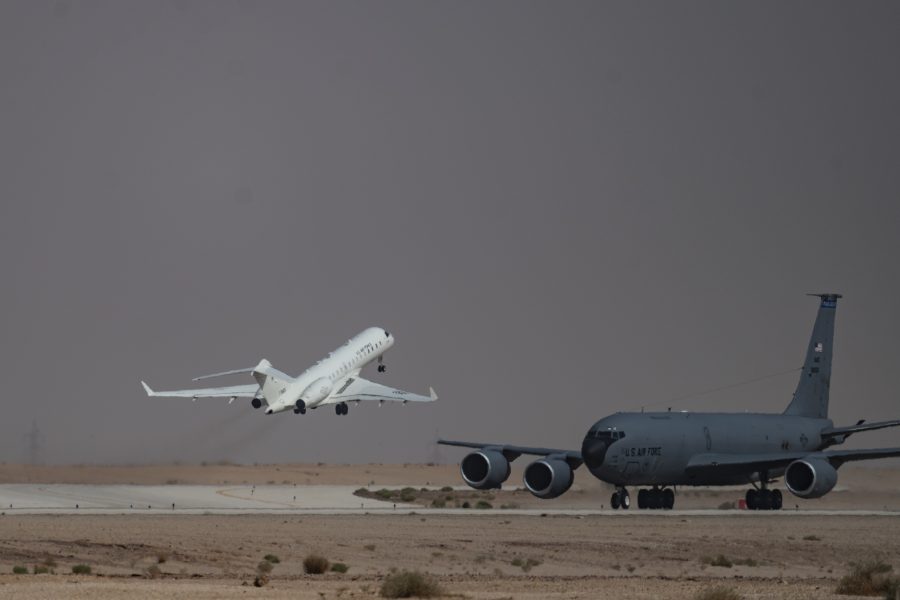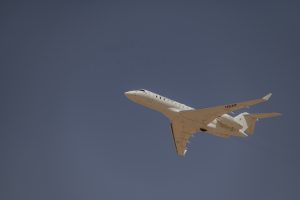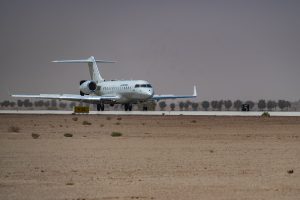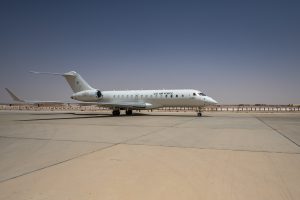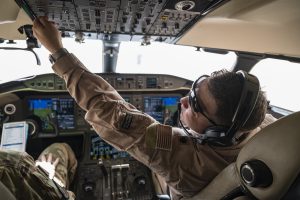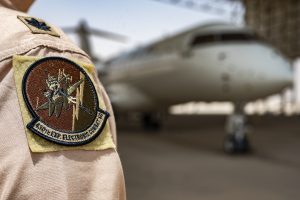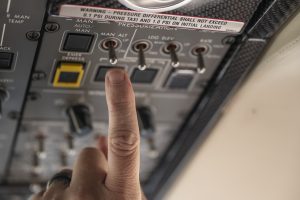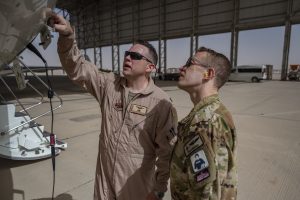Amid the reduction in America’s airpower in the Middle East, one asset has proven its resilience: the E-11A Battlefield Airborne Communications Node (BACN) aircraft of the 430th Expeditionary Electronic Combat Squadron.
This high-demand asset remains key in maintaining communications for U.S. and coalition military operations. Despite its placement in a global hotspot, Air Forces Central (AFCENT) has only a handful of fighter squadrons and limited mobility aircraft to meet considerable demands. The same goes for the E-11As and approximately 20 aviators that remain on call 24/7.
Air & Space Forces Magazine had a rare opportunity to talk to the Airmen who fly critical missions in the Middle East as pilots on the E-11A BACN, commonly pronounced “bacon.”
The E-11As help the Air Force, other American services, and a myriad of coalition partners communicate via radio and share data. During the U.S.’s years in Afghanistan, the aircraft also extended the range of communications links to mountainous terrain, which led to the aircraft’s ability to be likened to “Wi-Fi in the sky.”
“It’s catchy, but it doesn’t thoroughly represent really the nature of the BACN mission,” Lt. Col. R. Clayton McCart, the squadron commander, said of the nickname. Instead of merely extending range, McCart said, the E-11 takes different types of information and ensures that it is compatible with a wide variety of platforms.
“The big thing is that’s between dissimilar platforms with varying electronic capabilities,” McCart explained. “Modern warfare requires communications … or conveying data, and in a joint and interoperable way. Those data sources are often dissimilar. So we’re really [applicable] to many different mission sets.”
McCart and pilots under his command in the 430th EECS declined to discuss where they were based or operational details of most missions, as a condition of offering a rare glimpse at the E-11’s role in the Air Force’s most active combat zone.
But the Airmen did discuss the E-11’s role in one mission that has put Airmen and aircraft to the test: the humanitarian aid airdrops over Gaza that AFCENT has been conducting since March. The U.S. coordinates its missions with its Jordanian-based planning cell, often drops alongside the Royal Jordanian Air Force, and must deconflict airspace with Israel and other nations. E-11s have supported a total 33 U.S. airdrops into Gaza, AFCENT said, fulfilling the mission each time.
“I think we do a really good job with the U.S. Air Force as far as our communication goes. But when coalition forces are speaking a different language, not literally, but figuratively, then we’re able to take that, regardless of whatever systems they are running, and integrate that,” said Capt. Britton Ellington, an E-11 pilot, who has flown missions to support humanitarian aid airdrops. “We have a considerable stand-off range where we’re able to link up a lot of those players, kind of translate all those languages, and convert those into something that everyone can understand and see.”
USAF aircraft have been involved in defending U.S. troops from aerial threats in Iraq and Syria, conducting airstrikes against Iranian-aligned militia targets, supporting efforts to fend off Houthi attacks on commercial shipping in Yemen, and flying missions in support of Operation Inherent Resolve, the campaign against the Islamic State group. So the life of an E-11 crew can be a busy one.
“We’re not constrained to just the airdrops, this is multifaceted and directional, and so we’re on call by the Combined Air Operations Center,” McCart said. “We’re at their beck and call and the ATO [air tasking order] that comes out of the CAOC.”
Despite the lack of aerial refueling, the Bombardier business jet’s range—6,000 miles in the latest models—allows it to conduct multiple missions in one flight with a crew of just two pilots. The BACN payload is made by Northrop Grumman.
“What makes us beneficial in CENTCOM is sortie duration,” Ellington said. “We’re able to stay airborne through multiple vul times [vulnerability windows], if you will. We’re able to accomplish the airdrop and still have plenty of loiter time to accomplish other ATO tasks in the same day.”
McCart rattled off some of the capabilities that could be used in an ATO, including “cross-COCOM strike support” throughout CENTCOM.
One mission the BACN is no longer called upon to perform regularly is helping combat search and rescue (CSAR) operations, which is, in no small part, why the E-11 exists in the first place.
“That harkens all the way back to the early 2000s … the mountains and comm limitations of Afghanistan drove the need for beyond-line-of-sight communications,” McCart. “That’s where we were. And here’s where we are.”
The E-11 has proved its worth to the Air Force beyond the Middle East.
Though BACN has had a mission since 2008, the E-11 will have a permanent home at Robins Air Force Base, Ga., with the standup of the 18th Airborne Command and Control Squadron to form a more traditional home station and deployment model. Robins received another new E-11 in November. The Air Force wants a fleet of nine by the end of fiscal 2027, as the USAF takes delivery of roughly one new aircraft per year. The service had five aircraft in its inventory at the end of fiscal 2023.
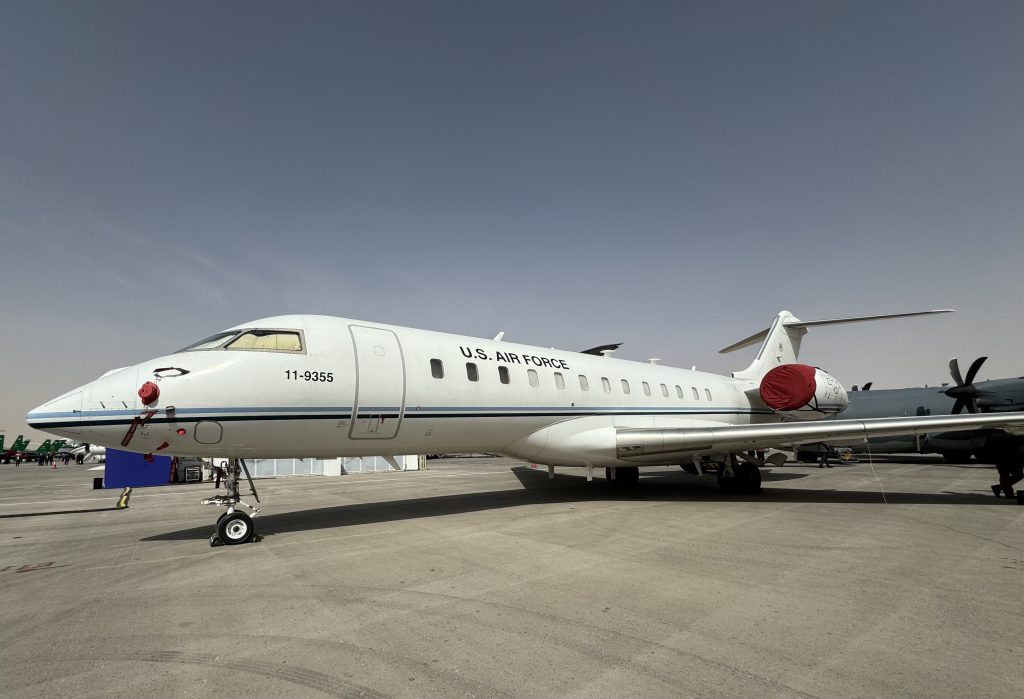
AFCENT declined to say how many E-11s are forward deployed. One E-11—a fourth of the fleet at the time—was lost and its two pilots were killed in a 2020 crash in Afghanistan.
Though the terrain of Afghanistan is not what the BACN crews confront these days, the basic mission of ensuring data and information reach the right place remains.
“I think what makes the E-11 so dynamic is it’s not just about mountains; it’s about any place where we have assets spread out, and the coalition aspect of this mission, where we have people coming from all over the world for a specific mission,” E-11 pilot Capt. Joseph Viteri said. “And so we position ourselves somewhere where we can actually be that glue. We can be that transfer of communication between one coalition member and get them closer to our other coalition members and get the mission completed. So that can happen over land, sea, mountains, desert, whatever, because of just the distances involved.”
